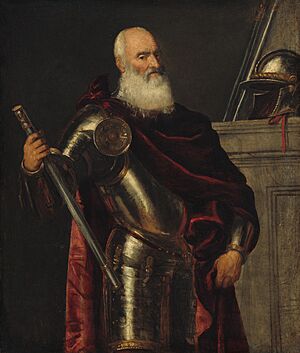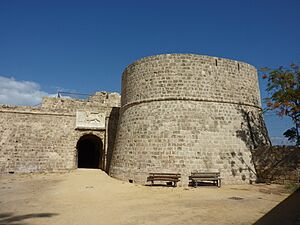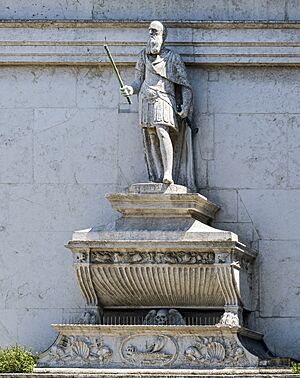Vincenzo Cappello facts for kids
Quick facts for kids
Vincenzo Cappello
|
|
|---|---|

Portrait of Cappello as a military commander, by Titian
|
|
| Born | 1469 Venice |
| Died | 19 August 1541 Venice |
| Buried |
Santa Maria Formosa
|
| Allegiance | |
| Service/ |
Venetian navy |
| Rank | Provveditore all'Armata |
| Battles/wars | War of the League of Cambrai, Hvar rebellion, Third Ottoman–Venetian War: Battle of Preveza |
Vincenzo Cappello (born in Venice in 1469 – died on August 19, 1541) was a noble and important leader from the Republic of Venice. He is best known for being the admiral of the Venetian navy during the famous Battle of Preveza.
Contents
Vincenzo Cappello's Life Story
Vincenzo Cappello was born in Venice in 1469. His father was Nicolò Cappello. We first hear about Vincenzo in October 1499. He was in Milan trying to sell a special necklace to King Louis XII of France. Later, in 1502 and 1504, he was chosen to be the state treasurer. This meant he managed the government's money.
Leading Trade Ships to England
In June 1504, Vincenzo was put in charge of a big group of trade ships called a muda. These ships were sailing to Flanders and London. This was one of the busiest and most profitable trade routes at the time.
After many months of getting ready, the ships finally sailed in February 1505. The trip was very successful. By July 1506, the Venetian ships were so full of goods for the return journey that they had to leave some wool behind!
On July 27, 1506, King Henry VII of England met with Cappello. The King gave him special trading rights and made him a knight. He even allowed Cappello to add the Tudor rose (a symbol of England) to his own family's coat of arms. Cappello also carried messages of friendship from the King back to the Republic of Venice. On the way home, Cappello had more good luck. His ships were attacked by a warship from Genoa that thought he was a pirate. He was taken to Cagliari, but he proved who he was. He even managed to buy new goods worth 6,000 gold coins (ducats) there.
When he returned to Venice on November 28, 1506, his ships were loaded with valuable goods. This made a big impression and helped him become very wealthy. Cappello used this wealth to start a career in politics.
Becoming a Politician and Military Leader
In April 1509, Cappello announced that he had loaned 10,000 gold coins to the Republic. Even though this was later denied, it made him very popular. He was quickly elected to the Venetian Senate, which was a powerful government group. While many people liked him, some also accused him of wanting too much power in the state.
Because of his popularity, he was elected to a very important job on January 14, 1512. He became the superintendent of the Venetian navy, known as Provveditore all'Armata. In this role, he showed great skill and knowledge about ships and naval matters. He also proved to be a mature political leader. The navy was in bad shape back then. It lacked organization, enough sailors, and even enough food (like hardtack, which are ship's biscuits) for the ships.
He tried to fix these problems, but the shortages caused difficulties. For example, in July 1514, at Corfu, he couldn't chase a group of twenty fast Ottoman ships because his fleet didn't have enough food. In December 1515, he had to send his fleet home in Istria. This happened because the officers and sailors demanded their pay, which was late. After these experiences, he wrote a strong report to the Venetian government. In it, he criticized how the navy was organized. During this time, he also helped defend Padua in February 1514 during the War of the League of Cambrai. After that, he went to stop the Hvar rebellion, which he did with great strictness.
Commander of Famagusta Fortress
In December 1515, he was chosen to be the fortress commander (capitano) at Famagusta on Cyprus. He had given 2,000 gold coins to the Republic for this role. Cappello found that the fortifications of Famagusta were not strong enough to defend against an Ottoman attack. He also said that the Venetian officials on the island were behaving "scandalously." He strongly believed that the Ottomans could not be trusted. So, he worked hard to make the city's defenses stronger. He managed to do this by spending only a small amount of extra money each month. His replacement, Bartolomeo Contarini, took over in March 1519 and praised Cappello's excellent work.
Becoming a High-Ranking Official
After leaving Famagusta on March 10, 1519, he returned to Venice on July 29. He continued his career in the Republic's government. He turned down a job as superintendent of fleet supplies in August. Instead, he became a member of the powerful Council of Ten in October. On June 19, 1520, he became an advisor to the Doge (the leader of Venice) for the Santa Croce district. Then, on September 9, 1520, he became the lieutenant-governor of Friuli. From this position, he carefully watched the Ottoman military movements in Dalmatia. He returned to Venice on June 7, 1522.
He was chosen to be an official representative to the new Pope, Adrian VI, in August. However, he did not go to Rome because of an outbreak of the plague there. He also became ill himself, which forced him to stay in Ferrara. He continued to serve in various important government roles, including being an advisor for the Cannaregio district in May 1523. He also participated in an investigation into government activities.
On September 12, 1529, he was again appointed as the superintendent of the navy (Provveditore all'Armata). Cappello knew about the navy's problems. He made specific demands to the government before accepting the job. He asked for enough sailors, food, and money. His disagreements with the Senate delayed his departure and created some tension. This tension remained even when he was re-appointed to the role in June 1532.
His task was to "restore order to the fleet." But he was told not to upset either the Ottoman Turks or the Holy Roman Emperor. This made his job very stressful. He was reappointed in 1534. In his reports to the Senate, he explained the lack of food, how sailors were leaving to join the Emperor's forces (which paid better), and how the defenses in Venice's overseas territories were weak. He also pointed out problems with how ships were built.
In 1535, he was elected as an advisor to the Doge for the Castello district. The Third Ottoman–Venetian War started in 1537. He was again elected as the superintendent of the navy. The combined fleets of Venice and its allies (especially Habsburg Spain) captured the fortress of Castelnuovo. They left a Spanish army there. However, the allied fleet was defeated by the Ottoman navy at the Battle of Preveza in September 1538. The Spanish blamed him for the defeat. He became ill and returned to Venice. There, he became a member of the Savi Grandi, a group of senior council members.
In January 1539, he helped elect Pietro Lando as the new Doge. He was also elected as a Procurator of St. Mark, which was a very high-ranking official position.
Vincenzo Cappello died on August 19, 1541. He was buried at the church of Santa Maria Formosa. The front of this church has a statue of him.
Sources
- Olivieri, Achille (1975). "CAPPELLO, Vincenzo" (in Italian). Dizionario Biografico degli Italiani, Volume 18: Canella–Cappello. Rome: Istituto dell'Enciclopedia Italiana. http://www.treccani.it/enciclopedia/vincenzo-cappello_(Dizionario-Biografico)-(Dizionario-Biografico)/.



